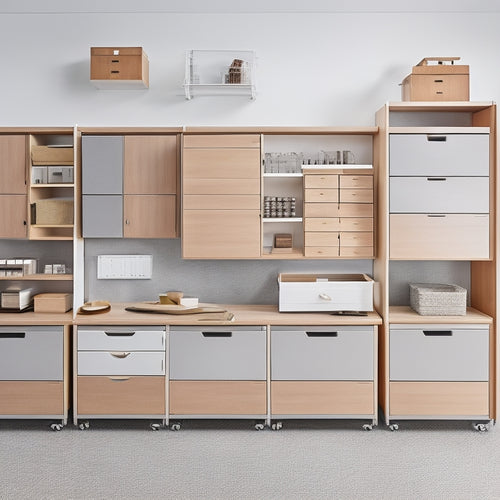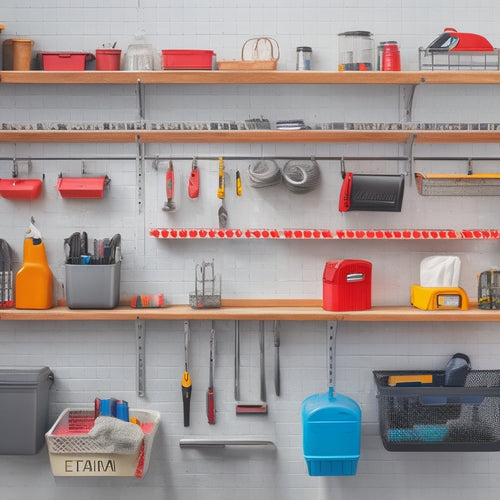
Streamline Your Toolbox With These 3 Essential Tips
Share
You're wasting time and decreasing productivity every time you have to search for a misplaced tool or navigate a cluttered workspace. To streamline your toolbox, start by simplifying your workspace - clear your workbench, sort items into categories, and create an ergonomic layout. Next, optimize tool accessibility by designating a 'hot zone' for frequently used tools and using vertical dividers to separate tools into categories. Finally, maximize vertical storage by installing shelves, bins, and hooks. By following these three essential tips, you'll be well on your way to a more efficient workspace - and there's even more you can do to take your toolbox to the next level.
Key Takeaways
• Designate a 'hot zone' for frequently used tools and position them within easy reach to optimize accessibility and efficiency.
• Implement a categorization system for tools, using labels and dividers to separate them into groups and facilitate quick location.
• Maximize vertical storage by installing shelves, bins, and hooks to store less frequently used items and free up floor space.
• Establish a routine for regular tool inspection, cleaning, and maintenance to prolong their lifespan and prevent damage.
• Create a tool inventory list and conduct regular decluttering to ensure only necessary tools are stored and easily accessible.
Simplify Your Workspace
Clear everything off your workbench and sort items into categories, such as tools, materials, and projects, to create a sense of control and focus. This is the first step in simplifying your workspace. By decluttering your workspaces, you'll increase efficiency and reduce the time spent searching for misplaced items.
Next, create ergonomic layouts that reduce strain on your body. Position your most frequently used tools and materials within easy reach to minimize stretching and bending. Consider the height and distance of your work surface, ensuring it's comfortable for you to work at. A well-designed layout will help you stay focused and avoid fatigue.
Optimize Tool Accessibility
As you work to streamline your toolbox, optimizing tool accessibility is essential. Five necessary tool groups should be positioned within easy reach to minimize downtime and maximize productivity. This guarantees that you can quickly grab the tools you need, without disrupting your workflow.
To accomplish this, consider the following accessibility solutions:
-
Designate a 'hot zone': Reserve a specific area of your toolbox for frequently used tools, keeping them within easy reach.
-
Use vertical dividers: Separate tools into categories, making it simpler to find what you need at a glance.
-
Implement a 'first-in, first-out' system: Store new tools behind existing ones, making sure that older tools are used before they expire or become obsolete.
-
Label and sign tools: Clearly label each tool and its storage location, reducing time spent searching.
-
Store heavy tools at the bottom: Keep heavy tools on lower shelves or in easy-to-lift containers, preventing strain and injury.
Maximize Vertical Storage
By installing shelves, bins, and hooks that maximize your toolbox's vertical storage capacity, you can greatly increase the amount of tools you can store in a small footprint. This is especially important when working with limited space.
Consider installing wall-mounted shelves to store less frequently used items, keeping them out of the way but still accessible. Hanging hooks can also be used to hang items like cords, hoses, or accessories, freeing up valuable floor space.
To further optimize your vertical storage, use stacking bins to store smaller items like nuts, bolts, or fasteners. These bins can be easily labeled and stacked on top of each other, making it easy to find what you need quickly.
If you need to move tools or supplies around the workspace, consider using rolling carts with drawers or shelves. These carts can be easily maneuvered and provide additional storage space.
Frequently Asked Questions
How Do I Deal With Cords and Cables Cluttering My Workspace?
"Out of clutter, find simplicity," they say. You tackle cord clutter by implementing cable management strategies, like cord organizers and zip ties, to free up space, boost efficiency, and create a more organized workspace that serves you and others.
What Are Some Creative Ways to Repurpose Old Toolboxes?
You can breathe new life into old toolboxes by repurposing them as planters or converting them into storage shelves. Add a personal touch by refinishing or decorating the toolbox to fit your style or the recipient's.
Can I Customize My Toolbox to Fit My Specific Needs?
"Can you imagine having a toolbox that's tailored to your unique needs? You can! By designing a custom toolbox organization and personalized tool storage, you'll boost efficiency and make serving others a breeze."
How Often Should I Clean and Maintain My Toolbox?
You should clean and maintain your toolbox regularly, ideally every 1-2 months, to prevent rust and damage. Organize tools by category, store them in designated areas, and label each section for efficient access.
What Are Some Budget-Friendly Toolbox Organization Solutions?
You're on a mission to tame the toolbox chaos! Invest in affordable storage solutions like stackable bins and repurposed containers, or get creative with DIY projects like pegboards and magnetic strips to maximize space.
Related Posts
-

Modular Tool Storage Systems for Small Spaces
You can optimize your small workspace by leveraging modular tool storage systems that intelligently employ vertical s...
-

Heavy-Duty Pegboard Hooks for Industrial Use
You need heavy-duty pegboard hooks that can withstand the rigors of industrial use, providing a reliable and efficien...
-

3 Simple Steps to a Garage Tool Wall You'll Love
To create a garage tool wall you'll love, start by planning the space, taking inventory of your tools, and measuring ...


